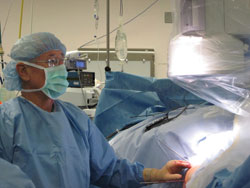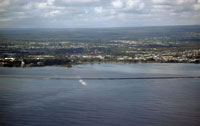Surgeon flies own plane around Hawaiian Islands to provide orthopedic care
Thomas C. Owens, MD, also has a seaplane rating, allowing him to fly planes for landing and taking off in water.
Thomas C. Owens, MD, used to rely on commercial airlines to get him to his orthopedic clinics on the Hawaiian Islands, which meant a lot of time spent sitting in airports waiting for flights.
One day, Owens had an idea: “I thought, I can do this myself. Why do I have to wait on airplanes and hang around airports when I can fly my own airplanes?” Owens, an orthopedic surgeon based in Honolulu, said. “It was freedom of motion.
“And the flying is beautiful, spectacularly beautiful,” he continued. “You can fly in the evening, under the stars with Venus or Jupiter on your wing. You can navigate by the stars. Nights are beautiful — full of optical illusions. In the daytime, the cloud patterns are just unbelievable.”
First flight
Owens first started flying as a child with his stepdad. He started his adult flying career in 2000.
|
Images: Owens TC |
With his instructor, an anesthesiologist named Kevin Wolley, MD, Owens spent about 100 hours in the air to obtain his private pilot license. Owens also has a seaplane rating, which means he is licensed to fly planes that are equipped to take off and land in water. He enjoys the challenges of seaplane or floatplane flying.
“There is so much drag with the floats that you have to point the nose down steeply in order to keep your airspeed up,” he said.
Owens loves to use “stick and rudder” flying, which involves assessing the plane’s attitude, how it turns and how it behaves without instruments.
“Good old pilots love stick and rudder flying,” he said.
When flying between the islands, however, he is more conservative, he told Orthopedics Today. “It’s more direct and business travel, so we’re not out horsing around.”
Single-engine, low-wing plane
Owens flies his single-engine, low-wing plane to visit three clinics: one on Molokai, one in Hilo and one in Kona. Most of his work involves arthroscopic joint reconstruction and arthroplasties for the hip, knee and shoulder.
“Our patients are appreciative of our efforts traveling on their behalf,” Owens said. “They are a wonderful, colorful diverse group — from pig hunters, to surfers, to cowboys, to athletes and retirees. Traveling to Honolulu can be difficult for them. Hawaii’s amazing people are a pleasure to know and serve.”
|
|
Owens and his nurse, Jackie Keliikoa, RN, travel to Molokai and Hilo once a month. They visit Kona about two to three times a month. They fly just about every week, he said. Owens hopes to continue these trips for another 5 to 10 years or “as long as we can get gas,” he joked.
Through his work, Owens has found that many of his patients are also fellow pilots.
“There is an amazing number of pilots, many more than you would ever expect. I have more old pilots from World War II, pilots from Vietnam, pilots who have flown everywhere in the world. The problem becomes: do we talk about orthopedic surgery and their knee or shoulder, or do we talk about flying?”
Similar environments
The operating room and the cockpit require similar skills, Owens noted.
“Just as in an operative environment in surgery where we know that we have to pay attention to detail, in an airplane it’s a mental discipline where you also have to pay attention to detail,” he said.
Attention to detail is critical when flying in rough weather. On one flight, Owens was flying in the rain with two orthopedic manufacturer representatives.
“Our weighted balance sheet was just at the very limits of what you could ordinarily fly with,” he said. As they approached Waimea, on the Big Island, Owens attempted to drop the landing gear at 3,000 feet elevation.
|
|
|
“The airplane started to go down, and I couldn’t get enough power with the gear down to get to the end of the field with a strong headwind and rain,” he said. “It was just showers, but wet air doesn’t support [the plane] as well.”
Owens had to retract the gear and “fly straight to the field, drop the gear and put the airplane on the ground like a rock.”
Flight challenges
Just departing from the Molokai airport, which is situated in a valley between two mountains, presents challenges, Owens said. The airport’s location makes takeoff more interesting, especially on windy days, he said.
“On some windy days on the climb-out, if you go straight head, you could hit the mountain,” he said. “You have to make sure that you don’t just trust what you see out the window because the nose will look up, and you won’t see it.”
It is critical to use common sense and turn away from the mountain, he said.
Owens is always seeking to improve as both a pilot and a surgeon. At this year’s Arthroscopy Association of North America meeting, he was struck by a talk that Major Chad H. Greer, a flight safety officer for the 162nd Fighter Wing in the Arizona National Guard gave on debriefing.
“We’re starting to add debriefing after cases with our operating room group, and we’re starting to debrief after an interesting flight,” he said. “I like the idea of not only doing the best we can for others, but also then making it better through debriefing. We are looking at ways for performance improvement.”– by Colleen Owens
- Thomas C. Owens, MD, can be reached at 405 N. Kuakini St., Suite 1109, Honolulu, HI 96817-6300; 808-521-8585; email: owenst005@hawaii.rr.com.




